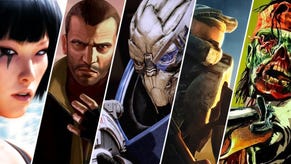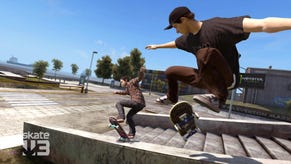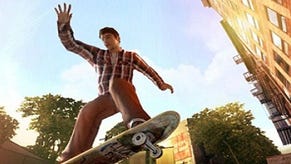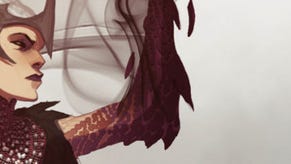Remembering Skate 3 on Its 10th Anniversary: Why the Time is Now for a Revival
Remembering EA's seminal and defunct Skate series as its last entry turns 10.
This article first appeared on USgamer, a partner publication of VG247. Some content, such as this article, has been migrated to VG247 for posterity after USgamer's closure - but it has not been edited or further vetted by the VG247 team.
I remember the first time I ate s**t trying to skate. I was a big Tony Hawk's Pro Skater fan, like all 12-year-olds. I thought Bam Margera was very cool, like all 12-year-olds. I begged my mom for a skateboard. For my birthday, I got one: A hot pink Element board with neon yellow trucks, which I still own to this day, though now it just ferries my laundry to the laundromat and back. I took my skateboarding nice and slow, but one day, I thought I'd try to ollie, or kickflip. I don't remember which. But I fell and twisted my arm upon landing, and in my knee-jerk attempt to break my fall, scraped my arm so bad that it was black like the asphalt in the parking lot. I cried like a baby, of course.
Skating was not as easy as it seemed in the Tony Hawk games, where reaching astronomical heights in a half-pipe was really just about building up momentum and hitting a bunch of buttons. It was Skate that helped teach me yes, no duh, skateboarding is dangerous work. Just like that, my naivety fell away.
It's been a long time since we last saw a Skate game; long enough that nostalgia for the series is basically a cottage industry. Whenever Electronic Arts teases something, the Twitch chat, the YouTube comments, the Twitter and Instagram replies, all join together in one big chorus: #Skate4. Everyone wants Skate 4, a sequel to the hit skateboarding simulation series that ditched the arcade gameplay of the Tony Hawk's Pro Skater series. Tony Hawk was great, but Skate took skateboarding seriously-seriously. Then it vanished.

It's fair to say that skateboarding games in general have been noticeably absent through this console generation. Olli Olli, something of a side-scrolling runner, was a welcome, though different, return to the arcade side of skateboarding games. Tony Hawk's Pro Skater attempted a revival in 2015, but that's best never dwelled on again. Indie developers have attempted other skateboarding exercises in video games, like the upcoming Skater XL from Easy Day productions, and crea-ture Studios' Early Access game Session. Meanwhile, the only sign of life for the Skate franchise is an enhanced backward compatible update of Skate 3 for Xbox One.
It's strange because in the past few years alone, it feels like skateboarding is as big as it was when I was a kid. Locally in San Francisco, I've watched crews such as GX1000 rise to prominence—it's not out of the ordinary to watch members of their crew, or at least people inspired by them, bombing down one of the city's giant hills. Skateboarding is everywhere again, and was even due to make its debut in the delayed Summer 2020 Olympics.
That brings me to today's anniversary: Skate 3 turns 10 years old. It released on PlayStation 3 and Xbox 360, a console era from what feels like a lifetime ago. It was not just the last hurrah for the more hardcore skateboarding sim, but the last game to release under EA Black Box—a now defunct game studio that was, for a time, the lead developer on both the Skate series and the Need for Speed series. The series has been dead and buried ever since.
Now's the time to bring it back.
It All Started on Paper
It all started on literal paper. At least, it did according to executive producer Scott Blackwood.
The trio at EA—Blackwood, Jay Balmer, and Chris Parry—imagined a world in which there was never a skateboarding game, and workshopped Skate's innovative controls then and there. "We did it on whiteboards and paper, and in fact, the control scheme, we came up with that pretty much on paper. It was a crazy, risky thing to undo eight years of convention in skateboarding and just throw it out the window and say, 'No, we're going to do this,'" Blackwood told Gamasutra. "Imagine if someone did a driving game and reversed steering and put acceleration on a different [control scheme layout]... it would be crazy. No one would ever do that."
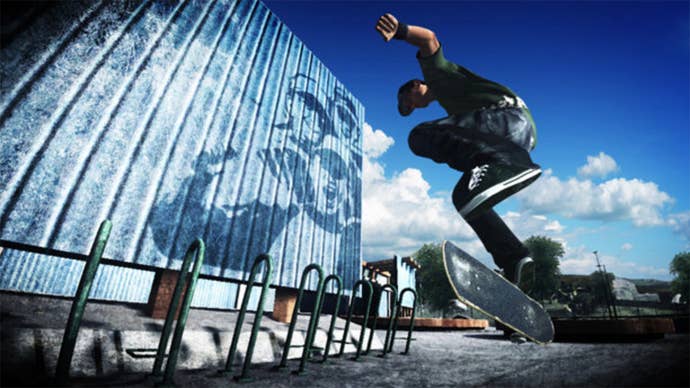
This approach resulted in a sim that has always carried a different sort of legacy than its genre predecessor, the pioneer Tony Hawk's Pro Skater (and Tony Hawk's Underground). Instead of mashing buttons for combos, its analog stick-driven "Flickit" control scheme considers each foot on the board. A kickflip takes a bit to figure out how to land. It isn't just about hitting square quickly in succession. A 900 isn't a simple analogue tilt away.
In an interview with IGN, Blackwood described the methodology driving the unique approach to skateboarding controls. "So the feeling you get is not of being a beginner skater that needs to learn the basics, but the feeling of being a skater who already knows the basics and is just discovering what else you can do," he said. It wasn't about chaining impossible combos, it was about logically building on what we already knew about skating.
Another pivotal factor of Skate was its embodiment of not just the sport, but of the scene as a whole. It leaned on creating skate videos. Players could make their own skate videos, highly edited, soundtracked to music, a compilation of tricks and (in some cases) mishaps. Skate videos have long been a pastime in skateboarding, even going as far back in video game form to collecting skate videos in early Tony Hawk's Pro Skater games. Skate put the editing in players' hands, as they shared and cut their own skate videos in-game. (The new game Session also has its own robust in-game video editor.)
Skate as a series started in 2007. Professional skateboarder Danny Way, primarily known for jumping the Great Wall of China, was lead creative consultant on the project, alongside EA's Balmer, Blackwood, and Parry. Way helped wrangle fellow famous skaters to mo-cap and jump on board the game. "My credibility is tremendously on the line, especially because I helped put so many big-name riders in the game and I promised them a game that represents real skateboarding," Way told Transworld Skate in 2007. "I would feel pretty guilty if s**t didn't work out correctly. Well, not guilty, but I'd feel like a real asshole."
But Way was confident in working with EA on Skate, given Balmer and Parry's prominence in Vancouver's skate community already. Their visions for a great skateboarding game that wasn't under the Tony Hawk banner aligned—"more realistic and not so exaggerated"—and Skate was born.
What made Skate especially stand out in the extreme sports game crowd was its dependence on realism, from feel to its lower camera angle. In the aforementioned pre-release interview with IGN, Blackwood cites skaters' inherent fear of injury as a primary roadblock in the game's design. When someone is on a board, there is always that nagging feeling of falling holding them back. That's hard, if not impossible, to convey in a video game.

"There is an absence of any real fear in the game that lets you take 100 tries at a trick with maybe only one successful landing," Blackwood said. "There are risks and injuries in the game, but it wouldn't be fun if they resulted in 'game over' or if the game was locked for weeks due to an injury. So we will see many attempts at crazy tricks and successful results where in reality nobody ever would have tried it. Of course, Danny Way has changed our view of what is possible."
It's worth mentioning the strange context Skate released in: the motion control boom. It released just shy of Wii Fit, Nintendo's arcade-y minigame collection that promoted players to work up a sweat. Big publishers like EA and Activision, the former especially, buckled down to cater to the trend, leading to strange experiments like Tony Hawk's Ride, NHL Slapshot, and of course, the Skate spinoff Skate It, which utilized Wii Fit's Balance Board. A gimmicky spinoff didn't sour the Skate audience however.
In 2008, EA introduced its mighty lucrative Ultimate Team, which it proceeded to graft onto all its sports games, minus Skate. FIFA, Madden, and others had their own versions of the collectathon mode. It thrived on players buying and collecting sports players to create their, well, ultimate team. To this day, it's a major money maker for EA: Ultimate Team generated 28% of EA's total net revenue in 2019, according to the company's 10-K report. Perhaps Skate's inability to be lucrative in the same way is one of the reasons why the series slowly dissipated.
Skate had its fair share of skateboarding stars appear in-game. Jason Lee, Eric Koston, Chris Cole, and more appeared throughout the series. One of its most recognizable skaters was Rob Dyrdek, who rose to fame for the MTV reality show Rob & Big—a heartwarming series about two best friends, their mini horse, and their bulldog. Like most skaters that have appeared in video games, he was a vocal fan.
"One of the best things to me about Skate is that if you play this game from beginning to end, you just got a complete education on what skateboarding is professional skateboarder and star of Rob & Big, Rob Dyrdek told ESPN in 2008 before the launch of Skate 2. "With the technology and the way the controls work, the way you flick the stick to do kickflips is exactly how you envision doing them in real life, so even without a board, you're getting mentally educated on how tricks work. You have to remember, when we were kids, it was about sliding on the ground. We didn't have anything like this game to open our eyes to the possibilities of what can be done until the videos slowly started coming out."
Skate 3 Perfected The Formula
Skate was always seen as a trilogy, according to Blackwood. In the aforementioned interview with Gamasutra, the producer notes that not only was Skate 2 basically designed at the same time as the first game, but all three had a planned trajectory.
"We looked at it as a three-game plan," he said. "We knew where we wanted to get to in the first, and we knew that even with the first one, we couldn't get off-board, and some people would be kind of bummed. 'Oh, I want to get off the board.' But to make getting off-board really pay off, it would've taken away from our skating. Do you want ollie inward heels, or do you want off-board?"
Skate 3 in turn further built on the creativity the first two games in the series inspired. It introduced a skate park editor called Skate.Park-more robust than Skate 2's skate spot creator—and teams, so players could play together more easily. It cast away San Vanelona for the new fictional city Port Carverton, a locale that embraced skateboarding rather than chastised you for it. (There was no evading security guards and the like anymore.) The original soundtrack was a trifecta between Bay Area legend Del the Funky Homosapien, Mark Mothersbaugh, and John King.
Skate 3 was the Skate promise fulfilled: teaching players not just about skateboarding, but the culture and communities it thrived in. Players were encouraged to build up their own communities within the game, thanks to its greater emphasis on online play and how progression would always carry over, no matter who you were playing with. Players could upload their unique designs or skate parks, and share them.
There was, too, the weird capitalist bend of the narrative. In the career mode, players were tasked with building up their "brand," with the end goal being to sell a heck of a lot of boards. In retrospect, it runs almost counter to what the gameplay encourages—with its emphasis on sharing creations and playing online in designated teams. I never got into the creation stuff—what can I say, I'm lazy—but I remember skating alongside friends quite fondly, as I'd laugh at watching them fumble a simple grind.
For the Skate series' developers, skateboarding was always a deep-rooted passion beyond the digital, and that passion always reflected in the games at hand. "I'm from skateboarding, and at the end of the day when this surreal dream of working on a video game, when it ends, I'll still be at the skateboard park skating," Chris Parry told Engadget ahead of Skate 3. "At the end of the day, that's what we said, is that we didn't want to mess up skateboarding, because we still have to live it."

This could be the year of skateboarding's big comeback in video games. Professional skaters Lizzie Armanto and Jason Dill in the past couple years have both outright discussed the existence of a new Tony Hawk's Pro Skater in development. Dill also recently talked about a Skate 3 mobile port that was in discussion "10 months ago." He told EA to make Skate 4 instead.
Following crews like GX1000 as an adult, and skateboarding in general as a kid and teenager, I've witnessed firsthand how skateboarding has really always been about togetherness, first and foremost. In Jonah Hill's directorial debut mid90s, starring Sunny Suljic (Atreus in God of War), we watch as the young Stevie finds kinship in a welcoming skate crew, escaping from his tough life at home. It's the thread in pretty much any skateboarding movie, and it's something that Skate always understood, and championed. Skateboarding isn't just a sport or hobby, it's an escape and community.
The desire for a new Skate game has been especially hitting me close as of late. I've been watching my tween cousin grow into an incredible skater. In just a few short years, he's gone from kid-hobbyist who was elated when I got him a Thrasher shirt for Christmas, to Instagramming every grind or fall. He humors me when I tell him to get a bandaid for a scrape, but beyond the light joking, I'm really just so proud of him. It's warmed my heart beyond its limits; he's doing what I could never do because I scraped my arm and cried like a baby that one time. At my aunt's house months ago, his friend said to me that it'd be great if there was a new Skate game—to them, real skaters who grew up with this, it's their nostalgia speaking.
The kids need a new Skate game, EA, so won't you humor them too?



